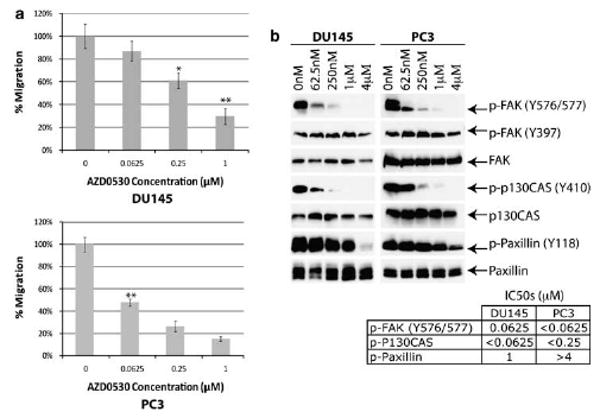This product is for research use only, not for human use. We do not sell to patients.

| Size | Price | Stock |
|---|---|---|
| 500mg | $700 | Check With Us |
| 1g | $1150 | Check With Us |
| 5g | $2900 | Check With Us |
Cat #: V0664 CAS #: 379231-04-6 Purity ≥ 98%
Description: Saracatinib (formerly also known as AZD-0530; AZD0530) is a novel, potent Src kinase inhibitor with potential antineoplastic activity. It inhibits Src with an IC50 of 2.7 nM in cell-free assays, and also potently inhibits other kinases such as c-Yes, Fyn, Lyn, Blk, Fgr and Lck; Saracatinib is less active against Abl and EGFR (L858R and L861Q). Saracatinib exhibits excellent in vivo antitumor efficacy in various tumors such as Src3T3 allografts, DU145, Calu-6, MDA-MB-231, AsPc-1 and BT474C xenografts. It has been reported to inhibit Src activation in DU145 and PC3 cell lines (prostate cancer cell lines). Both of c-Myc and cyclin D1 expression are decreased by Saracatinib. Saracatinib can inhibit the ERK1/2 and GSK3b phosphorylation as well as decrease β-catenin level in cells. Saracatinib inhibits the prostate tumor cell growth by inducing cycle arrest at G1/S phase. Saracatinib dose-dependently blocks cell migration in DU145 and PC3 cell lines.
References: [1]. Green TP, et al. Preclinical anticancer activity of the potent, oral Src inhibitor AZD0530. Mol Oncol, 2009, 3(3), 248-261.
Publications Citing InvivoChem Products
Product Promise

- Physicochemical and Storage Information
- Protocol
- Related Biological Data
- Stock Solution Preparation
- Quality Control Documentation
| Molecular Weight (MW) | 542.03 |
|---|---|
| Molecular Formula | C27H32ClN5O5 |
| CAS No. | 379231-04-6 |
| Storage | -20℃ for 3 years in powder formr |
| -80℃ for 2 years in solvent | |
| Solubility In Vitro | DMSO: 35 mg/mL (64.6 mM)r |
| Water: <1 mg/mLrr | |
| Ethanol: 31 mg/mL (57.2 mM) | |
| Solubility In Vivo | 2% DMSO+30% PEG 300+ddH2O: 5 mg/mL |
| SMILES Code | CN1CCN(CCOC2=CC3=NC=NC(NC4=C5OCOC5=CC=C4Cl)=C3C(OC6CCOCC6)=C2)CC1 |
| Synonyms | AZD0530; Saracatinib; AZD-0530; AZD 0530 |
| Protocol | In Vitro | In vitro activity: Saracatinib also potently inhibits other Src tyrosine kinase family members including c-Yes, Fyn, Lyn, Blk, Fgr, and Lck with IC50 from 4-10 nM. Saracatinib sensitively inhibits Src Y530F NIH 3T3 with IC50 of 80 nM. Saracatinib significantly impairs the invasion of HT1080 cells through a 3-dimensional collagen matrix and completely inhibits EGF-induced cell scattering in NBT-II bladder cancer cells. Saracatinib potent inhibits Src activation in DU145 and PC3 cells, which through inhibition of Y419 phosphorylation. Saracatinib inhibits the growth of prostate cancer including PC3, DU145, CWR22Rv1 and LNCaP, while Saracatinib shows low activity in LAPC-4, PZ-HPV7 and RWPE-1 cells. Saracatinib induces cell cycle arrest at G1/S but not caspase 3 cleavages. Saracatinib also significantly inhibits DU145 and PC3 migration in the Boyden chamber. Saracatinib gives a potent and sustained blockage of AKT and enhances the sensitivity to irradiation in A549 and Calu-6 cells. Saracatinib inhibits osteoclast in activity, resorption and formation. Saracatinib also reversibly prevents osteoclast precursor migration. Kinase Assay: IC50 of tyrosine kinase activity is measured by an enzyme-linked immunosorbent assay (ELISA) with recombinant catalytic domains of a panel of receptor and non-receptor tyrosine kinases (in some cases only part of the catalytic domain is used). Saracatinib dose ranges from 0.001-10 mM. Specificity assays against a panel of serine/threonine kinases are performed using a filter capture assay with 32P. Briefly, multidrop 384 plates containing 0.5 μL Saracatinib or controls (DMSO) alone or pH 3.0 buffer controls) are incubated with 15 μL of enzyme plus peptide/protein substrate for 5 min before the reaction is initiated by the addition of 10 μL of 20 mM Mg-ATP. For all enzymes the final concentration is approximated to the Michaelis constant (Km). Assays are carried out for 30min at room temperature before termination by the addition of 5 μL orthophosphoric acid. After mixing, the well contents are harvested onto a P81 Unifilter plate, using orthophosphoric acid as the wash buffer. Then IC50 is calculated. Cell Assay: Cells (PC3, DU145, CWR22Rv1, LNCaP, LAPC-4, PZ-HPV7 and RWPE-1 cells) are seeded at a density of 2× 103 in 96-well plates and incubated overnight. Then Saracatinib (62.5 nM-16 mM) is added to the cells. After 1, 3 and 5 days, culture medium is removed followed by addition of 0.2 mL DMSO per well and continuous shaking of plates at 200 rotations per minute for 15min. Then IC50 is measured by MTT method. |
|---|---|---|
| In Vivo | Saracatinib shows great tumor growth inhibition in Src3T3 allografts and a moderate growth delay in Calu-6, MDA-MB-231, AsPc-1 and BT474C xenografts. Saracatinib shows great antitumor activity in orthotopic DU145 xenograft mice at a dose of 25mg/kg (orally administered, daily). | |
| Animal model | CB17 mice are implanted with DU145 cells. | |
| Formulation | issolved in 0.5% hydroxypropyl methylcellulose, 0.1% Tween 80 | |
| Dosages | 25 mg/kg; Oral gavage |
| Solvent volume to be added | Mass (the weight of a compound) | |||
|---|---|---|---|---|
| Mother liquor concentration | 1mg | 5mg | 10mg | 20mg |
| 1mM | 1.8449 mL | 9.2246 mL | 18.4492 mL | 36.8983 mL |
| 5mM | 0.3690 mL | 1.8449 mL | 3.6898 mL | 7.3797 mL |
| 10mM | 0.1845 mL | 0.9225 mL | 1.8449 mL | 3.6898 mL |
| 20mM | 0.0922 mL | 0.4612 mL | 0.9225 mL | 1.8449 mL |
This equation is commonly abbreviated as: C1 V1 = C2 V2
- (1) Please be sure that the solution is clear before the addition of next solvent. Dissolution methods like vortex, ultrasound or warming and heat may be used to aid dissolving.
- (2) Be sure to add the solvent(s) in order.










































